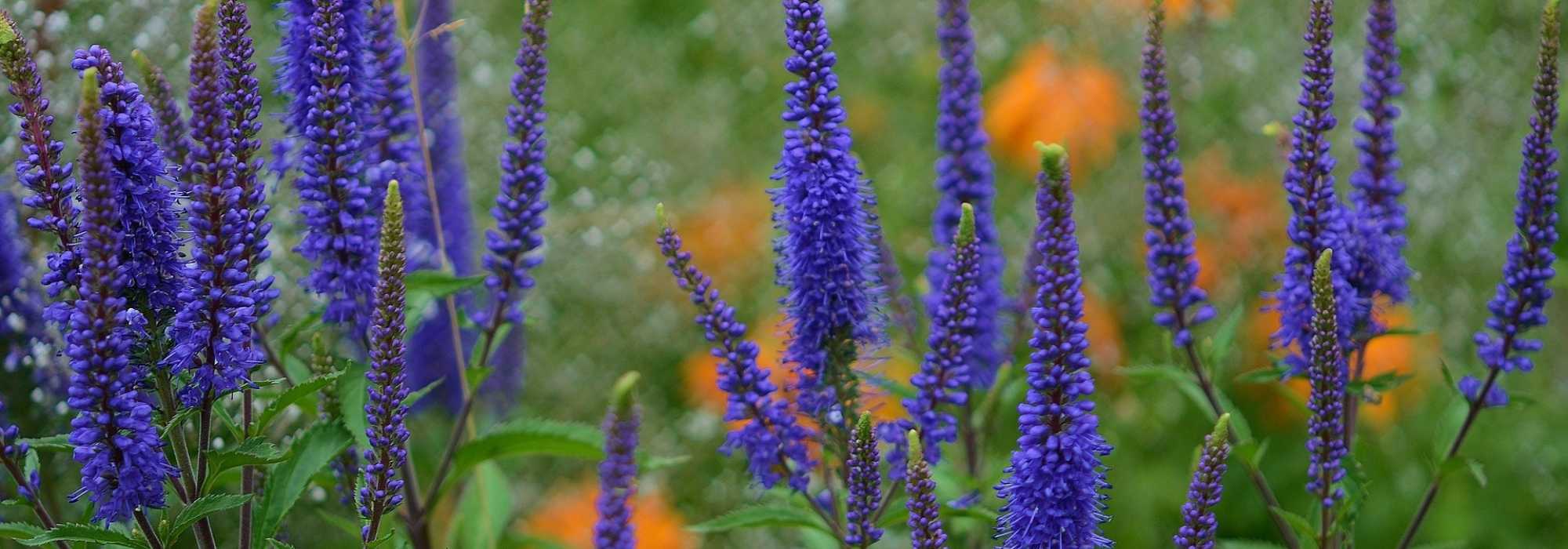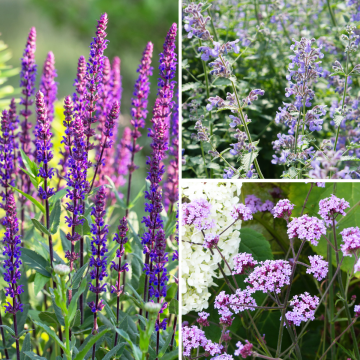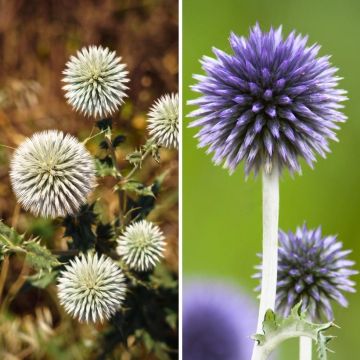

Spiked Veronica Collection
Spiked Veronica Collection
Veronica spicata Royal Candles, Alba, Rotfuchs
Spiked Speedwell
Special offer!
Receive a €20 voucher for any order over €90 (excluding delivery costs, credit notes, and plastic-free options)!
1- Add your favorite plants to your cart.
2- Once you have reached €90, confirm your order (you can even choose the delivery date!).
3- As soon as your order is shipped, you will receive an email containing your voucher code, valid for 3 months (90 days).
Your voucher is unique and can only be used once, for any order with a minimum value of €20, excluding delivery costs.
Can be combined with other current offers, non-divisible and non-refundable.
Home or relay delivery (depending on size and destination)
Schedule delivery date,
and select date in basket
This plant carries a 12 months recovery warranty
More information
We guarantee the quality of our plants for a full growing cycle, and will replace at our expense any plant that fails to recover under normal climatic and planting conditions.
Would this plant suit my garden?
Set up your Plantfit profile →
Collection items (3 plants)
Description
This Spiked Speedwells or Veronica spicata collection is a selection of remarkable perennials known for their long and abundant summer flowering. The varieties 'Royal Candles', 'Alba', and 'Rotfuchs' offer a beautiful range of colours, from intense blue to bright white and fuchsia red. They prefer sunny exposures and adapt to various types of well-drained soils. Once established, these plants tolerate moderate periods of drought and can withstand our cold winters. Their nectariferous flower spikes bloom throughout the summer and are welcome in gardens promoting biodiversity.
The collection consists of:
1 x Veronica spicata 'Royal Candles': This variety features dense spikes of bright blue flowers, reaching a height of 50-60 cm, which pair beautifully with silver or purple foliage.
1 x Veronica spicata 'Alba': This white form of the species stands out with pure white flowers, bringing a touch of light to the garden and forming a lovely contrast with dark or colourful foliage. When in bloom, the plant reaches a height of approximately 30-35 cm.
1 x Veronica spicata 'Rotfuchs': This selection offers a unique tone with its slender spikes in shades of red and tender fuchsia pink. It is perfect for enlivening floral compositions and attracting attention.
To welcome these Spiked Speedwells into your garden, choose the beginning of spring or early autumn. They thrive in well-drained garden soil, even limestone and relatively dry in summer. These plants flourish in borders, beds, or rockeries and can adorn the pond's edges or brighten up a flower pot. The taller varieties should be planted at the back to create a sense of depth. Allow a spacing of 30 cm between each plant to allow for optimal development, corresponding to 9 to 11 plants per square metre.
To accompany the Veronica spicata in this collection, opt for plants with similar sunlight and soil requirements. Grasses like Festuca glauca, with its bluish foliage, create a subtle contrast when planted in front of the veronicas, adding a different texture to a border or bed. Mix the veronicas with Salvia nemorosa 'Caradonna', with its purple-violet flower spikes. Their simultaneous flowering at the same height strengthens the structure of the bed. In the foreground, plant 'Rozanne' geraniums with blue flowers veined with purple. Their generous flowering and spreading habit allow for a smooth and colourful transition. Finally, behind these perennials, place Echinacea purpurea, whose large purple daisies will attract attention while supporting pollinating fauna, enriching the diversity and verticality of the garden.
Flowering
Foliage
Plant habit
Botanical data
Veronica
spicata
Royal Candles, Alba, Rotfuchs
Plantaginaceae
Spiked Speedwell
Cultivar or hybrid
Other Perennial collections
View all →Planting and care
The spike speedwell is a plant that likes sunny and well-drained soils, even poor ones. It grows best in somewhat chalky soil and doesn't like stagnant moisture in the winter more than in the cold. You can trim the faded stems, which look brownish. The dried-out stems are not always attractive, so it's best to remove them, which will also encourage new flowering. You can also let a few plants self-seed, but the new plants may not be identical to the parent plant. Either way, the clumps should be pruned in spring before new growth starts.
Planting period
Intended location
Care
Planting & care advice
This item has not been reviewed yet - be the first to leave a review about it.
Haven't found what you were looking for?
Hardiness is the lowest winter temperature a plant can endure without suffering serious damage or even dying. However, hardiness is affected by location (a sheltered area, such as a patio), protection (winter cover) and soil type (hardiness is improved by well-drained soil).

Photo Sharing Terms & Conditions
In order to encourage gardeners to interact and share their experiences, Promesse de fleurs offers various media enabling content to be uploaded onto its Site - in particular via the ‘Photo sharing’ module.
The User agrees to refrain from:
- Posting any content that is illegal, prejudicial, insulting, racist, inciteful to hatred, revisionist, contrary to public decency, that infringes on privacy or on the privacy rights of third parties, in particular the publicity rights of persons and goods, intellectual property rights, or the right to privacy.
- Submitting content on behalf of a third party;
- Impersonate the identity of a third party and/or publish any personal information about a third party;
In general, the User undertakes to refrain from any unethical behaviour.
All Content (in particular text, comments, files, images, photos, videos, creative works, etc.), which may be subject to property or intellectual property rights, image or other private rights, shall remain the property of the User, subject to the limited rights granted by the terms of the licence granted by Promesse de fleurs as stated below. Users are at liberty to publish or not to publish such Content on the Site, notably via the ‘Photo Sharing’ facility, and accept that this Content shall be made public and freely accessible, notably on the Internet.
Users further acknowledge, undertake to have ,and guarantee that they hold all necessary rights and permissions to publish such material on the Site, in particular with regard to the legislation in force pertaining to any privacy, property, intellectual property, image, or contractual rights, or rights of any other nature. By publishing such Content on the Site, Users acknowledge accepting full liability as publishers of the Content within the meaning of the law, and grant Promesse de fleurs, free of charge, an inclusive, worldwide licence for the said Content for the entire duration of its publication, including all reproduction, representation, up/downloading, displaying, performing, transmission, and storage rights.
Users also grant permission for their name to be linked to the Content and accept that this link may not always be made available.
By engaging in posting material, Users consent to their Content becoming automatically accessible on the Internet, in particular on other sites and/or blogs and/or web pages of the Promesse de fleurs site, including in particular social pages and the Promesse de fleurs catalogue.
Users may secure the removal of entrusted content free of charge by issuing a simple request via our contact form.
The flowering period indicated on our website applies to countries and regions located in USDA zone 8 (France, the United Kingdom, Ireland, the Netherlands, etc.)
It will vary according to where you live:
- In zones 9 to 10 (Italy, Spain, Greece, etc.), flowering will occur about 2 to 4 weeks earlier.
- In zones 6 to 7 (Germany, Poland, Slovenia, and lower mountainous regions), flowering will be delayed by 2 to 3 weeks.
- In zone 5 (Central Europe, Scandinavia), blooming will be delayed by 3 to 5 weeks.
In temperate climates, pruning of spring-flowering shrubs (forsythia, spireas, etc.) should be done just after flowering.
Pruning of summer-flowering shrubs (Indian Lilac, Perovskia, etc.) can be done in winter or spring.
In cold regions as well as with frost-sensitive plants, avoid pruning too early when severe frosts may still occur.
The planting period indicated on our website applies to countries and regions located in USDA zone 8 (France, United Kingdom, Ireland, Netherlands).
It will vary according to where you live:
- In Mediterranean zones (Marseille, Madrid, Milan, etc.), autumn and winter are the best planting periods.
- In continental zones (Strasbourg, Munich, Vienna, etc.), delay planting by 2 to 3 weeks in spring and bring it forward by 2 to 4 weeks in autumn.
- In mountainous regions (the Alps, Pyrenees, Carpathians, etc.), it is best to plant in late spring (May-June) or late summer (August-September).
The harvesting period indicated on our website applies to countries and regions in USDA zone 8 (France, England, Ireland, the Netherlands).
In colder areas (Scandinavia, Poland, Austria...) fruit and vegetable harvests are likely to be delayed by 3-4 weeks.
In warmer areas (Italy, Spain, Greece, etc.), harvesting will probably take place earlier, depending on weather conditions.
The sowing periods indicated on our website apply to countries and regions within USDA Zone 8 (France, UK, Ireland, Netherlands).
In colder areas (Scandinavia, Poland, Austria...), delay any outdoor sowing by 3-4 weeks, or sow under glass.
In warmer climes (Italy, Spain, Greece, etc.), bring outdoor sowing forward by a few weeks.






















































